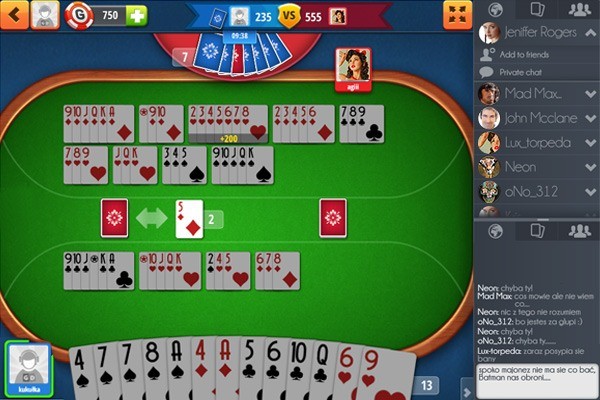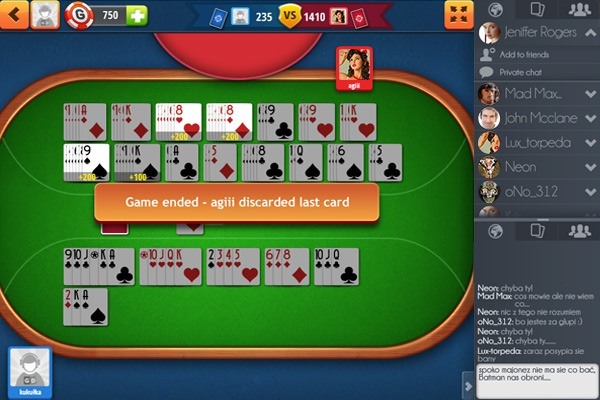Les règles du Buraco Fechado STBL - règles du jeu
Le Buraco est un jeu de cartes traditionnel originaire de l'Uruguay et de l'Argentine, inventé en 1940. De nos jours, c'est le jeu de cartes le plus populaire de toute l'Amérique du sud, notamment au Brésil. Il s'agit d'un jeu de type rami de la famille de la canasta. En portugais, « buraco » signifie « trou », ce qui correspond au sentiment de tristesse que l'on ressent en cas de défaite. Il existe de nombreuses variantes, les plus connues sont le Buraco Aberto (« ouvert ») et le Buraco Fechado (« fermé »).
Le Buraco Fechado peut se jouer à 2 ou 4 joueurs. S'il y a deux joueurs, la partie se déroule à 1 contre 1, s'il y en a quatre, elle se déroule à 2 contre 2. Lors des parties à 4 joueurs, chaque équipe met ses points en commun. Ce jeu se joue avec deux paquets de 54 cartes, incluant chacun deux jokers, soit un total de 108 cartes.
But du jeu
Le but du jeu est d'obtenir le plus haut score possible et de se débarrasser de toutes ses cartes. Contrairement à une partie de rami classique, il ne suffit pas de se débarrasser des 11 cartes de départ. En effet, une fois la main de départ posée, chaque joueur reçoit 11 cartes du rebut. Dès qu'un joueur s'est débarrassé de toutes ses cartes, la partie est terminée. Cependant, le vainqueur n'est pas nécessairement celui qui se débarrasse de toutes ses cartes, mais celui qui a accumulé le plus de points. Ce jeu se décompose donc en deux actions fondamentales : la formation de combinaisons et la défausse.
Score
Les joueurs gagnent des points pour chaque carte associée et peuvent gagner des points supplémentaires en formant des combinaisons spéciales (les canastas). Les joueurs peuvent aussi subir des pénalités de points.
Liste des actions permettant de gagner des points :
- Associer la dernière carte et ainsi mettre fin à la partie (100 points).
- Associer des cartes, former des combinaisons et des canastas :
- 2 (10 points)
- Joker (50 points)
- Ace (15 points)
- K, Q, J, 10, 9, 8 (10 points)
- 7, 6, 5, 4, 3 (5 points)
- Canasta « impure » (100 points)
- Canasta « pure » (200 points)
- Canasta 500 (500 points)
- Canasta complète (1000 points)
Liste des actions engendrant une perte de points :
- Le joueur possède encore des cartes à la fin de la partie,
- Le joueur (ou l'un des joueurs en 2 contre 2) n'a pas eu le temps de piocher le rebut avant la fin de la partie (-100 points).
Combinaisons
Pour effectuer une combinaison, les joueurs doivent associer au moins 3 cartes de la même couleur. Par exemple : J ♥, 10♥, 9♥.
Canastas
Les canastas sont des combinaisons d'au moins 7 cartes de la même couleur formant une suite. Elles rapportent des points supplémentaires aux joueurs qui les réalisent. Les canastas ont une influence fondamentale sur le score final.
Il existe plusieurs canastas différentes !
- Canasta pure (sans joker).
- Canasta impure (avec joker).
- Canasta 500 (de l'as au Roi – As, 2, 3, 4... Roi – sans joker) – la combinaison doit être réalisée en une seule fois.
- Canasta complète (de l'as à l'as – As, 2, 3, 4... As – sans joker) – la combinaison doit être réalisée en une seule fois.
Passe-partout (2 et joker)
Les passe-partout sont des cartes spéciales pouvant remplacer n'importe quelle autre carte. Il s'agit des 2 et des jokers. Lorsqu'un joueur réalise une combinaison ou une canasta avec une carte passe-partout, elle est considérée comme « impure ». Les canastas « impures » rapportent moins de points que les canastas « pures »
Les joueurs peuvent placer les 2 et les jokers n'importe où afin de former une combinaison ou une canasta. Par exemple, si un joueur forme la combinaison J♠, 2♥, K♠, il peut ajouter Q♠ au tour suivant. Une fois la dame ajoutée, la nouvelle combinaison sera : 2♥, J♠, Q♠, K♠ (ici, le (2♥ remplace le 10♠). Les jokers fonctionnent exactement de la même manière.
Les 2 fonctionnent aussi comme des cartes normales. Par conséquent, si un joueur utilise un 2 en tant que joker dans une combinaison de la même couleur que ce 2, il peut par la suite changer cette combinaison impure en combinaison pure (cette règle s'applique aussi aux canastas). Par exemple, si un joueur a réalisé la combinaison 3♠, 2♠, 5♠, le 2 pourra par la suite être déplacé au tout début de la combinaison afin de la « purifier ». Cela devient alors : 2♠, 3♠, 4♠, 5♠.
Pour commencer
Au début de la partie, chaque joueur reçoit 11 cartes. On forme ensuite deux rebuts de 11 cartes chacun. Chaque rebut est attribué à un joueur (en 1 contre 1) ou à une équipe (en 2 contre 2). Les autres cartes forment la pioche.
Lorsque le premier joueur commence, il prend une carte dans la pioche. Il peut alors associer les cartes afin de former des combinaisons. S'il ne peut pas former de combinaisons (ou s'il ne le veut pas), il défausse une carte sur le rebut. En se défaussant, il met fin à son tour.
En 1 contre 1, chaque joueur associe ses propres cartes et forme ses propres combinaisons. En 2 contre 2, les joueurs jouent ensemble et peuvent donc former des combinaisons à deux.
Déroulement de la partie
Au cours des tours suivants, chaque joueur prendre une carte du rebut ou de la pioche. Afin de piocher les cartes du rebut, il faut suivre les règles ci-dessous. Après avoir pioché, les joueurs peuvent constituer des combinaisons, ajouter des cartes aux combinaisons déjà constituées ou simplement défausser une carte. Il faut réfléchir au meilleur moyen d'associer les cartes afin d'obtenir le meilleur score possible.
Dès qu'un joueur a défaussé les 11 cartes de sa main, il reçoit 11 cartes du rebut. S'il parvient à s'en débarrasser, la partie prend fin. Pour pouvoir défausser leur dernière carte, les joueurs doivent avoir un moins une canasta « pure ».
Le rebut
Le rebut constitue la principale différence entre le « Buraco Aberto » et le « Buraco Fechado STBL ». Cette variante est régie par plusieurs règles :
- Il est interdit de ne prendre qu'une carte au rebut – si un joueur décide de prendre une carte au rebut, il doit les prendre toutes.
- Seule la dernière carte du rebut est visible (se souvenir des cartes situées en-dessous constitue donc un avantage).
- Lorsqu'un joueur prendre une carte au rebut, il doit immédiatement utiliser la première carte.
- Le joueur ne pourra utiliser les autres cartes du rebut qu'une fois qu'il aura utilisé la première carte.
- Si la première carte est un joker ou un 2, il doit former une nouvelle combinaison (s'il ne peut pas, il ne peut pas piocher le rebut).
- Les joueurs savent combien il y a de cartes au rebut car c'est inscrit à côté de la pile.
Fin de la partie
La partie se termine lorsque :
- Un joueur (ou une équipe) s'est débarrassé de toutes ses cartes, a pioché le rebut et a réussi à faire une canasta « pure ».
- Toutes les cartes de la pioche et du rebut ont été utilisées.
À la fin de la partie, le joueur qui a posé la dernière carte gagne 100 points. Son ou ses adversaires perdent des points pour chaque carte encore en leur possession – le nombre de points perdu correspondant à la valeur des cartes. Le joueur ou l'équipe ayant le score le plus élevé remporte la partie.





